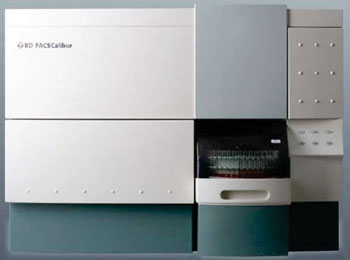Novel IVD Assay Tested for Heparin-Induced Thrombocytopenia
By LabMedica International staff writers
Posted on 31 Mar 2014
Laboratory tests to support clinical diagnosis of heparin-induced thrombocytopenia (HIT) are subdivided into functional, platelet activation assays that lack standardization, or immunological assays, which have moderate specificity toward HIT.Posted on 31 Mar 2014
HIT is caused by the interaction of platelet-activating antibodies of immunoglobulin G (IgG) class with large complexes of platelet factor 4 (PF4) bound to heparin on platelets, resulting in platelet activation and subsequent triggering of the coagulation pathway.

Image: The Fluorescent activated cell sorter FACSCalibur (Photo courtesy of BD Bioscience).
Hematologists at the Institute for Clinical Transfusion Medicine and Children Hospital (Braunschweig, Germany) and an international team of scientists, monitored 346 patients with suspected HIT. From each patient, citrated platelet-poor plasmas (PPP) and sera was obtained. Patient sera were analyzed with PF4 IgG enzyme-linked immunosorbent assay (ELISA) or by Particle Gel Immuno Assay (PaGIA).
These assays were compared with the HITAlert Kit (IQ Products; Groningen, The Netherlands) where samples were measured and analyzed on standard flow cytometers, such as the FACS Calibur (BD Bioscience; Franklin Lakes, NJ, USA) capable of detecting fluorescein isothiocyanate (FITC) and R-Phycoerythrin (R-PE) fluorescence. HITAlert showed high sensitivity (88.2%) and specificity (99.1%) when compared with clinical diagnosis. Agreement of HITAlert with PF4 ELISA- and PF4 PaGIA-positive patients is low (52.7 and 23.2%, respectively), while agreement with PF4 IgG ELISA- and PF4 PaGIA-negative patients is very high (98.1 and 99.1%, respectively).
The authors concluded that the HITAlert assay showed good performance towards HIT diagnosis. Whether applying this functional test upfront makes immunoassays redundant is a question that depends on local logistic and diagnostic equipment, such as the availability of flow cytometry and fresh platelets. The data presented suggests that such an approach is possible. HITAlert is reliable, easy to perform, rapid, and standardized as an in vitro diagnostic product (IVD-registered in Europe) for clinical practice. These properties make HITAlert very suitable for rapid testing of platelet activation due to heparin therapy, but also for testing platelet-activating properties of alternative coagulants. Future studies should further unravel HITAlert performance in patient groups with heparin-independent platelet activation events, including antiphospholipid syndrome (APS) patients and patients undergoing orthopedic surgery. The study was published in the April 2014 issue of the International Journal of Laboratory Hematology.
Related Links:
Institute for Clinical Transfusion Medicine and Children Hospital
IQ Products
BD Bioscience













